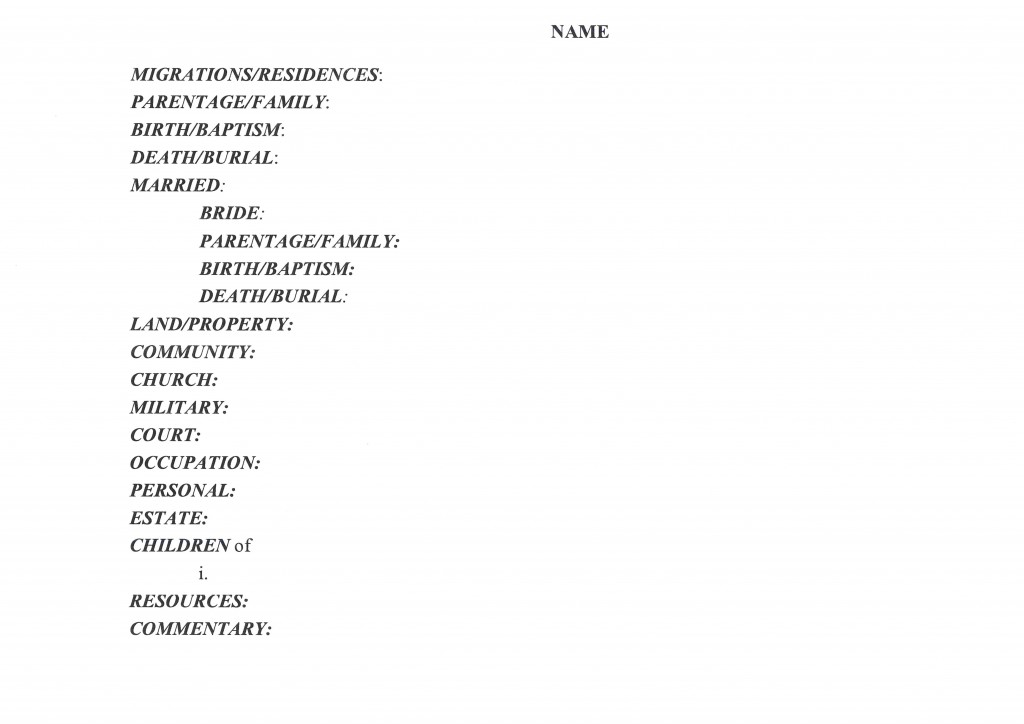 In a recent post I mentioned the Early New England Families Study Project “template” that I use: a Word document file with the categories pre-typed. I keep it on my desktop to open and “save as” the new file name each time I start a new family. For those of you who are knowledgeable about Word template files, you can set it up as such. As I do the research, I dump all the raw material into the form, then whittle it down as I proof, compare, and refine the text.
In a recent post I mentioned the Early New England Families Study Project “template” that I use: a Word document file with the categories pre-typed. I keep it on my desktop to open and “save as” the new file name each time I start a new family. For those of you who are knowledgeable about Word template files, you can set it up as such. As I do the research, I dump all the raw material into the form, then whittle it down as I proof, compare, and refine the text.

The first five steps were covered in the last post:
1. Review the Great Migration Study Project database (GM).
2. Review the Great Migration Newsletter (GMN).
3. Review Torrey’s Marriages (TM).
4. Create a Blocking Draft (BD).
5. Begin creating Research piles (RP).
and
6. Undertake a New Print Search (NPS) – see another, earlier post on this topic.
7. Thorough Periodical Search (TPS). Depending on what I have already searched, I go back to the “Journals and Periodicals” category on AmericanAncestors.org and search “all” databases. I may also go to the National Genealogical Society at ngsgenealogy.org where I have member access to the National Genealogical Society Quarterly back issues and index. I might also go to the hathitrust.org, about which I’ve written before, and possibly jstor.org if I am looking for historical studies about a particular time and place.
8. Colony Records and Histories (Colony). I have downloaded my own collection of these often overlooked but extremely valuable sources of seventeenth-century material, including Records of the Governor and Company of the Massachusetts Bay in New England, 1628-1686, Records of the Colony of New Plymouth in New England, The Public Records of the Colony of Connecticut, 1636-1776, Provincial Papers, Documents and Records Relating to the Province of New Hampshire from 1686 to 1722, and History of the State of Rhode Island and Providence Plantations, Vol. I 1636-1700. For sources such as these that I use frequently, every time I access an index page, I print it, then collect all the pages as a hard copy index, which I can annotate.
9. Vital Records (VR). Beginning with the “Vital Records (incl. Bible, Cemetery, Church, and SSDI)” category on AmericanAncestors.org, I’ll search all the relevant places in our comprehensive collection of Massachusetts, Rhode Island, and Connecticut records – including some manuscript vital records for unpublished towns (such as Hingham). For early Maine and New Hampshire VR, I go to Familysearch.org. If I want to see an original page of Massachusetts records, Familysearch has a browsable version of Massachusetts, Town and Vital Records, 1620-1988, but I have to go over to Ancestry.com for an indexed version.
The series continues here.
As a retired public school librarian and a now ‘sometime’ family historian, I find this is a super reminder of the excellent resources available. Thank you for this reminder collection. I look forward to more excellence.
Ann, thank you. It is turning into a useful exercise for me, too. One does not think about all the steps until one has to write them down!
I like the way your template organizes the information you save in the format in which you will write the person’s life, as well as organizing the research to be completed. Once the research is completed, the personal history only needs finishing and proofing.
Peter, thanks. It took a while to develop the format which, of course, borrows a lot from Great Migration. As a “visual” person, this helps me organize.